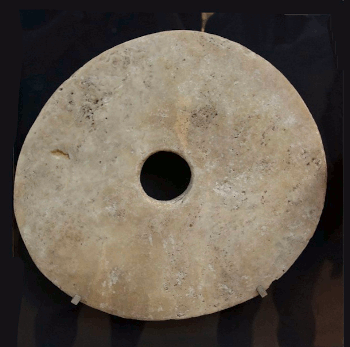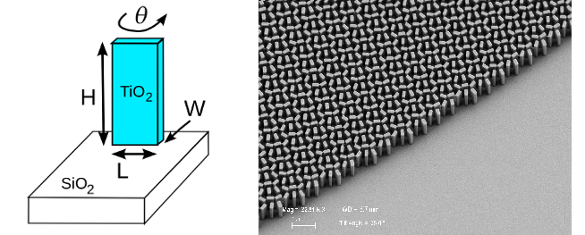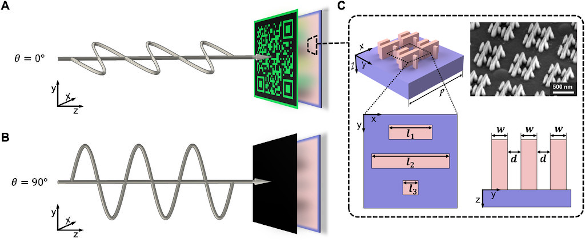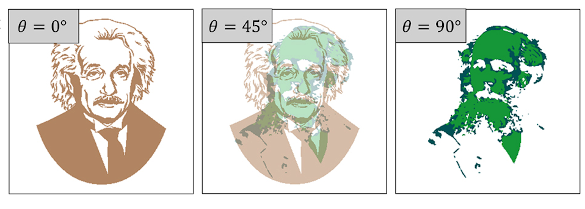Counterfeit Protection
March 15, 2021
As a
child in the BC years (Before
Computers), most of my
education and
entertainment came from reading
books and
magazines. Some of these books, such as
The Golden Book of Science (1956),
The Giant Golden Book of Mathematics (1960), and
zoologist,
Lancelot Hogben's,
The Wonderful World of Mathematics (1955), are still on my bookshelves. Other supposedly educational children's books were merely collections of
trivia designed to capture the interest of young readers.

Some children's books about science and math from the mid-20th century. From left to right, cover and frontpiece of the The Golden Book of Science (1956), cover and frontpiece of The Wonderful World of Mathematics (1955), and frontpiece of The Golden Encyclopedia (1946). (Scans of my copies. Click for larger image.)
One unforgettable piece of trivia from one of those books was an
illustration and explanation of the
Yap Island Rai stones, also known as
Yapese stone money. These are huge
disks with a
central hole carved from
limestone. The largest known of these is about 12
feet (3.6
meters) in
diameter, 20 inches (0.5 meter) thick, weighing 8,800
pounds (4,000
kilograms). These are known as a
primitive form of money and an example that anything can be money if it's
valued by many people. A
modern example would be
cryptocurrency. The value of one such cryptocurrency,
bitcoin, is about $30,000 at the time of this writing.

Is there any real difference between Yap Island Rai stones, also known as Yapese stone money, and bitcoin?
Each of these illustrates the economic principle that something has value when many people believe that it does.
An interesting example of this is the Dutch tulip mania of the early 17th century.
(Created using the GNU Image Manipulation Program (GIMP) from Wikimedia Commons source images of a Yap Stone Coin in the British Museum by Ken Eckert and a supposed bitcoin logo.)
The
world is presently transitioning to
digital currency, and all money transferred between the
Federal Reserve and US
banks is
electronic. However, in the past, the
paper dollar was king, and it was the sole method of
commerce. This led to the problem of
counterfeit money in which
criminals would produce dollar
imitations. After all, what could be simpler than
printing money? This led to escalating efforts by the
US Bureau of Engraving and Printing to make its dollar
distinguishable from a counterfeit dollar.
The first effort was to produce fine detail in printing that was impossible for a counterfeiter to do. This led to the
plots of many
B-movies in which
US Treasury agents searched for some superbly
engraved printing plates created by counterfeiters. Security was also in the
paper, being made from special
materials with embedded colored
threads. Over time, more
technologically advanced
anti-counterfeiting measures have been taken. These include the use of
holograms, embedded
strips, raised printing and
microprinting,
watermarking,
inks whose colors change depending on the
angle of the
light, and measuring the
fluorescence lifetime of embedded
phosphors.
As you can surmise, the
physics disciplines of
optics and
optical materials have contributed to anti-counterfeiting measures in currency. These, and others, are also being used for
consumer goods in creation of
anti-counterfeiting packaging and
anti-theft systems. I participated in
research in both of these areas. For anti-theft, my
magnetism background was applied in the area of
electro-magnetic security tags. My experience in phosphor materials was used in anti-counterfeiting.
Consumer packaging is adaptable to many more anti-theft and anti-counterfeiting technologies than currency. The most prominent of these for preventing theft of more expensive goods is the use of
radio-frequency identification (RFID) tags. There's an
arms race between
manufacturers and counterfeiters in this area, just as for currency; so, there's always a need for
innovation in low-cost measures. As the
Wikipedia article on anti-counterfeiting packaging states,
With the increasing sophistication of counterfeiters techniques, there is an increasing need for designers and technologists to develop even more creative solutions to distinguish genuine products from frauds, incorporating unique and less obvious aspects of identification into the design of goods.
A research team at the
Pohang University of Science & Technology (POSTECH, Pohang, South Korea) has gone beyond the simple hologram as an anti-counterfeiting measure to an optical tag that changes its image as a function of light
polarization.[1-2] The research team was led by
Junsuk Rho, a
professor of
mechanical engineering and
chemical engineering, and it included
graduate students from both disciplines.[2] This research is published as an
open access paper in
Nanophotonics.[1]
This
security tag is enabled by a
polarizer constructed as a
metamaterial. Metamaterial are materials whose unique properties are based on their
geometrical structure, rather than their
specific composition. In order for these to manipulate light, their features must be of the order of a
wavelength of light, about 500
nanometers, so they are enabled by
nanoscale technology. I wrote about such optical metamaterials in two previous articles,
Harvard Metamaterial Flat lens (July 4, 2016) and
Metamaterial Lenses (November 18, 2019). One such metamaterial is illustrated below.

A metamaterial lens developed at Harvard University.[3-4] This lens is built from many microstructures, each of which bend light to a focus. Left image, the process parameters for titanium dioxide pillars on silica. The phase shift of light through the lens at each point can be adjusted through rotation of the pillars. Right image, a scanning electron micrograph of the metamaterial lens. The titanium dioxide pillars are formed by atomic layer deposition on a silica glass substrate. (Left image, created using Inkscape. Right image, Capasso Lab image via Harvard University.)
The security tag
surface metamaterials, metasurfaces, allow display of full-color images during an
on state and show no images in an
off state; alternatively, they can switch between different images.[2] The technologically advanced processing makes it difficult to counterfeit. Says
Chunghwan Jung, the first
author of the
paper describing this research, "This new device is practically impossible to
forge because it requires an
electron microscope with
magnification capacity of several thousand and a nanometer-scale
production equipment."[2] This research was funded by the
Samsung Research Funding & Incubation Center for Future Technology.[2]

Principle of the metamaterial polarization security tag. The colors appear for horizontally polarized incident light (a), but are concealed for vertically polarized light (b). The metamaterial structure is shown at the right. (Fig. 1 of ref. 1,[1] also appearing here.[2] POSTECH illustration licensed under the Creative Commons Attribution 4.0 International License. Click for larger image.)

Overlapped images, portraits of Albert Einstein and Ludwig Boltzmann, are selected by different polarizations. The Boltzmann image is not as distinct, but it illustrates the principle. (Portion of Fig. 5 of ref. 1.[1] POSTECH illustration licensed under the Creative Commons Attribution 4.0 International License. Click for larger image.)
References:
- Chunghwan Jung, Younghwan Yang, Jaehyuck Jang, Trevon Badloe. Taejun Lee, Jungho Mun, Seong-Won Moon, and and Junsuk Rho, "Near-zero reflection of all-dielectric structural coloration enabling polarization-sensitive optical encryption with enhanced switchability," Nanophotonics, vol. 10, no. 2 (online, November 26, 2020), DOI:https://doi.org/10.1515/nanoph-2020-0440. This is an open access article, published under the Creative Commons Attribution 4.0International License. A PDF file is available at the article location.
- A display that completely blocks off counterfeits, Pohang University of Science & Technology (POSTECH) Press Release, January 21, 2021. Also available here.
- Mohammadreza Khorasaninejad, Wei Ting Chen, Robert C. Devlin, Jaewon Oh, Alexander Y. Zhu, and Federico Capasso, "Metalenses at visible wavelengths: Diffraction-limited focusing and subwavelength resolution imaging," Science, vol. 352, no. 6290 (June 3, 2016), pp. 1190-1194, DOI: 10.1126/science.aaf6644.
- Leah Burrows, "Metalens works in the visible spectrum, sees smaller than a wavelength of light," Harvard University Press Release, June 2, 2016.
Linked Keywords: Child; computer; education; entertainment; book; magazine; zoologist; Lancelot Hogben; trivia; Children's science and math books of the mid-20th century; cChildren's literature; children's books; science; mathematics; math; 20th century; book cover; book frontispiece; illustration; Yap Island; Rai stone; Yapese; rock (geology); stone; money; disk (mathematics); center (geometry); central; hole; carving; carve; limestone; foot (unit); feet; meter; diameter; pound (mass); kilogram; primitive culture; value (economics); modern history; cryptocurrency; bitcoin; economics; economic principle; Dutch tulip mania; 17th century; GNU Image Manipulation Program (GIMP); Wikimedia Commons; Yap Stone Coin in the British Museum; Ken Eckert; bitcoin logo; world; digital currency; Federal Reserve; bank; electronic; United States dollar; paper dollar; commerce; counterfeit money; crime; criminal; imitation; printing; US Bureau of Engraving and Printing; anti-counterfeiting measures; plot (narrative); B-movie; United States Department of the Treasury; Treasury agent; rotogravure; engraved printing plate; paper; material; thread; technology; technological; holography; hologram; stripe (pattern); strip; microprinting; watermark; watermarking; ink; angle; light; fluorescence lifetime; phosphor; physics; discipline (academia); optics; optical; final good; consumer goods; anti-counterfeiting packaging; anti-theft system; research; magnetism; electro-magnetic security tag; radio-frequency identification (RFID); arms race; manufacturing; manufacturer; innovation; Wikipedia; sophistication; industrial design; designer; technology; technologist; creativity; creative; genuine; fraud; Pohang University of Science & Technology (POSTECH, Pohang, South Korea); polarization (waves); Junsuk Rho; professor; mechanical engineering; chemical engineering; postgraduate education; graduate student; open access journal; open access paper; Nanophotonics (journal); electronic article surveillance; security tag; polarizer; metamaterial; geometrical structure; chemical compound; specific composition; wavelength; nanometer; nanoscopic scale; nanoscale technology; Harvard Metamaterial Flat lens; Metamaterial Lenses; Harvard University; microstructure; focus (optics); process parameter; titanium dioxide; column; pillar; silicon dioxide; silica; phase (waves); phase shift; light; lens (optics); rotation; scanning electron microscope; scanning electron micrograph; atomic layer deposition; silica glass; substrate; Inkscape; surface; Chunghwan Jung; author<; scientific literature; paper; forgery; forge; electron microscope; magnification; production equipment; Samsung; principle; horizontal; vertical; Creative Commons Attribution 4.0 International License; portrait; Albert Einstein; Ludwig Boltzmann.